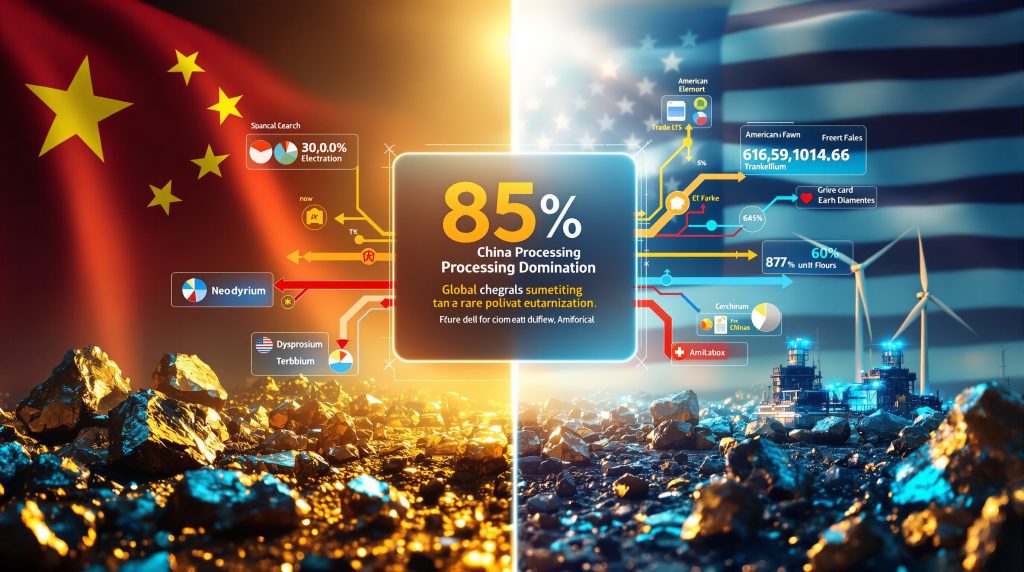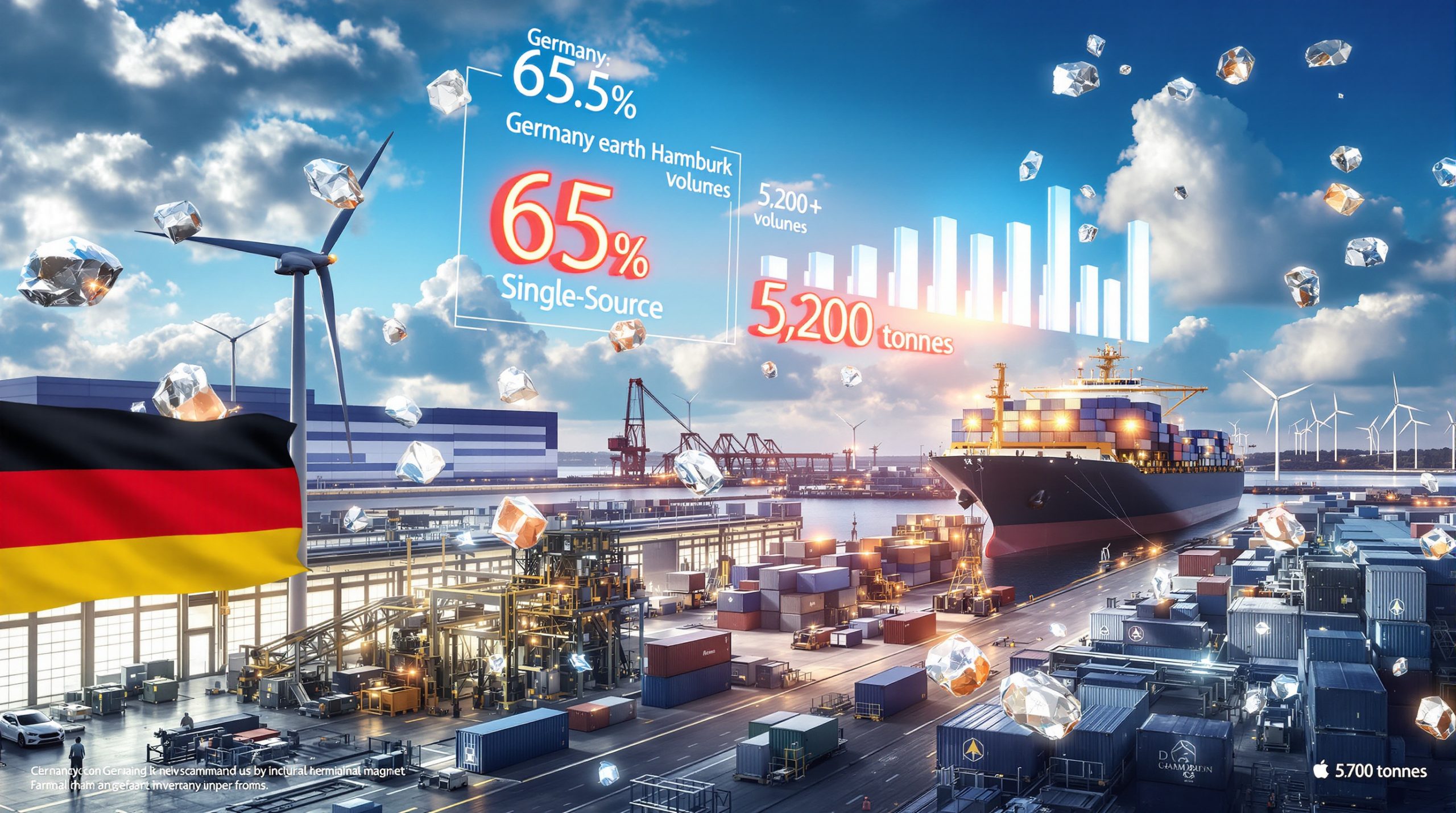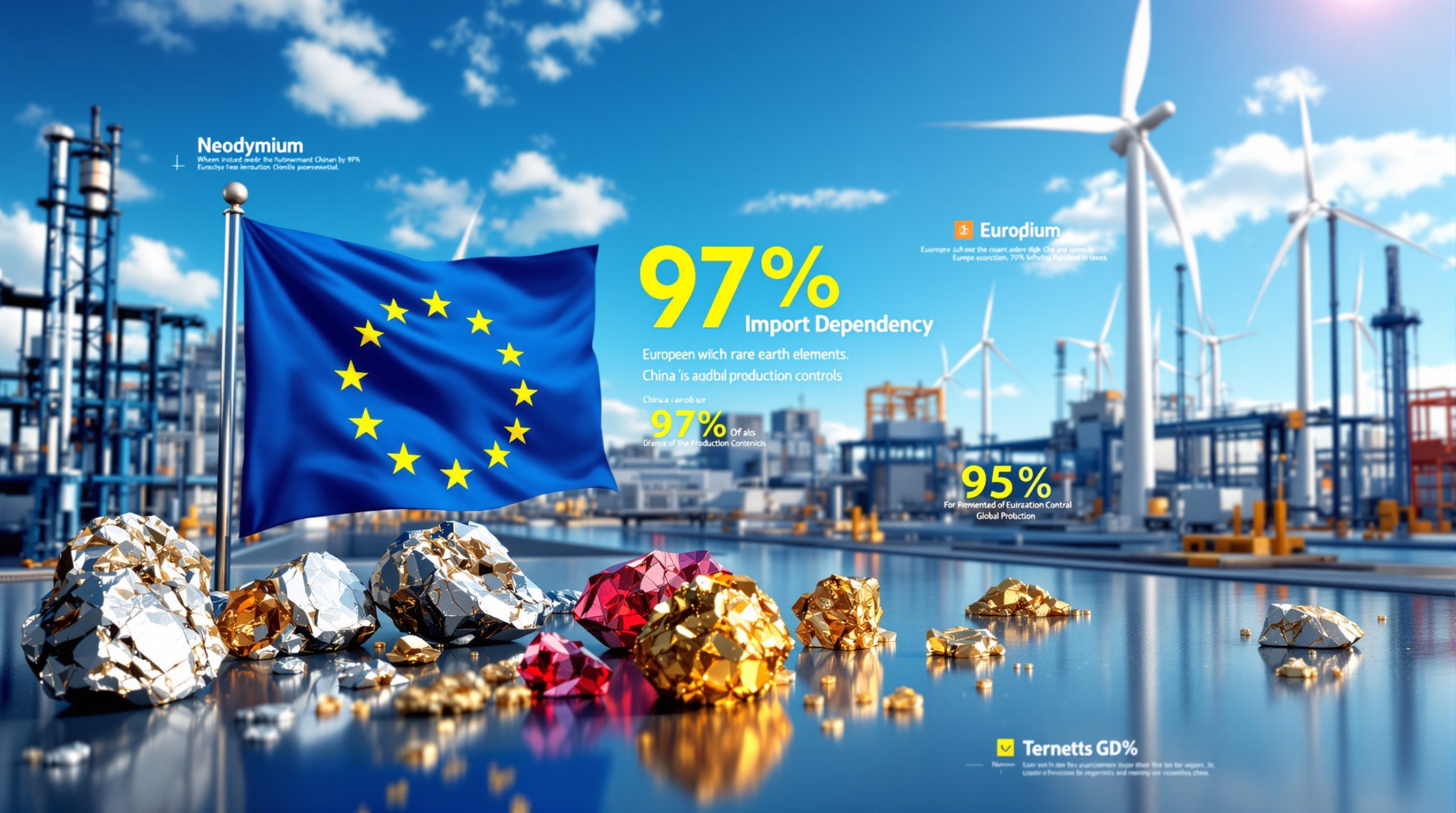The escalating friction between Washington and Beijing over rare-earth elements reflects deeper concerns about technological sovereignty and national security. These 17 metallic elements power everything from smartphones to wind turbines, making control over their supply chains a matter of strategic importance for major economies worldwide. As governments develop their critical minerals strategy, understanding these dynamics becomes crucial.
Recent market volatility demonstrates how quickly U.S.-China rare-earth trade tensions can shift investor sentiment. In October 2025, stocks of American rare-earth companies like MP Materials and USA Rare Earth experienced sharp declines following reports of potential trade rapprochement between the two superpowers. Rare earth miners fell as investors questioned the urgency of domestic supply chain development. This market reaction reveals the speculative nature of investments built around geopolitical tensions rather than fundamental industrial capacity.
The strategic value of rare earths extends beyond their physical properties. These elements enable technologies that define modern military capabilities, renewable energy systems, and advanced manufacturing processes. Control over their supply chains represents a form of economic leverage that can influence global technology development and national security planning.
What Makes China's Rare-Earth Dominance So Concerning?
China's stranglehold on rare-earth production extends far beyond mining operations. The country controls approximately 85% of global processing capacity, creating bottlenecks that cannot be easily replicated elsewhere. This dominance encompasses multiple critical stages of the supply chain, making any critical minerals reserve initiative particularly challenging to implement.
Processing Infrastructure: China has invested decades in building sophisticated separation and refining facilities. These installations require specialised chemical processes that few other countries have mastered at commercial scale.
Technical Expertise: The accumulated knowledge in complex rare-earth separation represents a competitive moat that cannot be quickly overcome. Chinese facilities have refined these processes over generations, achieving cost efficiencies that remain unmatched globally.
Cost Advantages: Lower labour costs, economies of scale, and historically relaxed environmental compliance standards have created structural cost advantages for Chinese processors.
Vertical Integration: China maintains control from mining through magnet manufacturing, allowing for optimised supply chain coordination and strategic inventory management.
The dominance becomes particularly pronounced in heavy rare earths (HREEs), where China controls 95% of global dysprosium production and 90% of terbium processing capacity. These elements prove essential for high-performance applications where substitution remains extremely difficult.
How Are Recent Policy Shifts Affecting Market Dynamics?
Export Control Mechanisms
Beijing has implemented increasingly sophisticated export controls that extend beyond simple quantity restrictions. These mechanisms include licensing requirements for rare-earth shipments, quotas limiting annual export volumes, and quality specifications that favour domestic processors over international customers.
Strategic stockpiling represents another policy tool, allowing Chinese authorities to influence global pricing through inventory releases or accumulation. This approach creates uncertainty for international buyers who cannot predict supply availability or pricing trends.
Market Response Patterns
Policy changes trigger predictable market reactions that reveal underlying supply chain vulnerabilities. Furthermore, the impact of these policies extends beyond immediate market movements to influence long-term strategic planning.
| Policy Action | Immediate Effect | Long-term Consequence |
|---|---|---|
| Export restrictions | Price volatility and supply disruptions | Investment in alternative sources |
| Licensing delays | Production bottlenecks | Development of domestic processing |
| Quota reductions | Inventory hoarding by buyers | Strategic stockpile creation |
| Quality specifications | Preference for Chinese suppliers | Technology transfer requirements |
Recent market movements illustrate how quickly sentiment can shift based on diplomatic headlines. When reports emerged in late 2025 suggesting improved U.S.-China relations, rare-earth stocks experienced immediate selling pressure as investors questioned the urgency of domestic supply chain development.
Why Do Trade Negotiations Keep Stalling on Rare Earths?
Competing Strategic Objectives
The fundamental challenge lies in irreconcilable goals between the major powers. The United States seeks guaranteed access to rare-earth supplies at stable prices, viewing these materials as essential for national security and technological competitiveness. China, meanwhile, aims to maintain strategic leverage while protecting its domestic rare-earth industry from international competition.
Technical realities complicate any negotiated solution. Processing capacity cannot be rapidly relocated or replicated, meaning that even successful negotiations would not immediately resolve supply chain vulnerabilities.
Structural Barriers to Resolution
Several factors systematically complicate meaningful progress in rare-earth trade discussions. In addition, these barriers interconnect to create persistent challenges for negotiators.
Environmental Regulations: Western countries maintain stricter environmental standards that increase the cost and complexity of rare-earth processing, making domestic production less competitive with Chinese facilities.
Capital Intensity: Rare-earth separation facilities require massive upfront investments and specialised technical expertise that take years to develop, creating high barriers to entry for new market participants.
Political Time Horizons: The timeframes required to build alternative supply chains exceed typical political cycles, making sustained policy commitment difficult to maintain across different administrations.
Technology Transfer Restrictions: Security concerns limit the sharing of processing technologies between countries, slowing the development of alternative supply sources.
What Alternative Supply Strategies Are Emerging?
Geographic Diversification Initiatives
Australia's Growing Role
Australia has emerged as a key player in rare-earth diversification efforts. Lynas Corporation operates the largest rare-earth processing facility outside China, with ongoing expansion of separation capabilities. The Mount Weld mine continues increasing production capacity while receiving government support for downstream processing development. This aligns with broader energy transition security objectives.
North American Development
MP Materials operates the Mountain Pass facility in California, which the company describes as spanning the entire supply chain from mining through magnet production. However, even this integrated operation acknowledges that heavy rare earths remain a significant bottleneck, with China maintaining control over most downstream separation and processing.
USA Rare Earth is developing operations in Oklahoma and Texas focused on sintered neodymium-iron-boron (NdFeB) magnets, mining at Round Top, Texas, and rare-earth processing capabilities.
Canadian rare-earth exploration projects and Mexican mining partnerships with U.S. companies represent additional diversification efforts, though most remain in early development stages.
African Opportunities
Several African nations present potential alternative sources:
- Tanzania's Ngualla project development shows promise for future production
- South African deposits contain significant heavy rare-earth potential
- Madagascar's emerging mining sector attracts international investment
Technology-Based Solutions
Recycling and Recovery
Advanced recycling technologies are reducing dependence on primary mining through several approaches. These innovations represent key aspects of industry innovation trends shaping the sector.
- Urban mining extracts rare earths from electronic waste streams
- Magnet recycling processes recover materials from end-of-life applications
- Battery material recovery systems capture rare earths from spent energy storage systems
Substitution Research
Scientific efforts focus on reducing rare-earth requirements through alternative approaches:
- Development of alternative magnet compositions that require fewer critical elements
- Synthetic material research aims to replicate rare-earth properties using more abundant elements
- Process optimisation reduces rare-earth consumption in existing applications
How Do Heavy Rare Earths Complicate the Supply Picture?
Heavy rare earths present unique challenges that distinguish them from light rare earths in terms of supply security and strategic importance.
Critical Applications
HREEs enable technologies where substitution remains particularly difficult:
High-Performance Permanent Magnets: Heavy rare earths like dysprosium and terbium are essential for magnets that maintain performance at high temperatures and in demanding applications.
Advanced Military Systems: Defence applications require the specialised properties that only heavy rare earths can provide, making supply security a national security priority.
Precision Manufacturing Equipment: Industrial applications demand the precise characteristics that heavy rare earths deliver, with few viable alternatives currently available.
Supply Concentration
China's dominance in heavy rare earths exceeds even its control over light rare earths. This concentration creates particular vulnerabilities for importing nations, especially as U.S.-China rare-earth trade tensions continue to influence global markets.
The processing of heavy rare earths requires even more specialised facilities and technical expertise than light rare earth separation. Chinese facilities have developed proprietary processes that remain difficult to replicate elsewhere.
Limited alternative sources are under development, with most projects focusing on light rare earths rather than the more technically challenging heavy elements.
What Role Do Stockpiling Strategies Play?
National Reserve Programs
Governments worldwide are building strategic stockpiles to buffer against supply disruptions and provide security during periods of market volatility.
U.S. Strategic Approach
The Defence Logistics Agency operates procurement programmes designed to secure critical materials for national security applications. Strategic stockpile expansion focuses on the most vulnerable elements where alternative sources remain limited.
Public-private partnership initiatives encourage domestic production while reducing government financial exposure through shared investment arrangements.
European Union Response
The Critical Raw Materials Act implementation coordinates member state efforts to secure alternative supply sources. Supply chain resilience funding supports development of processing capabilities within EU borders.
Member state coordination mechanisms aim to avoid duplicative efforts while ensuring adequate supply security across the region.
Private Sector Hedging
Companies are adopting various risk management strategies to reduce exposure to supply chain disruptions:
Long-term Supply Contracts: Manufacturers negotiate extended agreements with suppliers to secure predictable access to critical materials.
Inventory Buffer Increases: Companies maintain larger stockpiles than historically typical to provide cushion against supply interruptions.
Vertical Integration Investments: Some firms invest in upstream capabilities to reduce dependence on external suppliers for critical inputs.
How Do Environmental Concerns Influence Trade Dynamics?
Processing Challenges
Rare-earth separation generates significant environmental impacts that complicate supply chain development:
Radioactive Waste Management: Many rare-earth deposits contain thorium and uranium, requiring specialised disposal procedures that increase processing costs and regulatory complexity.
Acid Drainage Concerns: Processing operations use substantial quantities of acids that must be properly managed to prevent environmental contamination.
Water Contamination Risks: Separation processes can impact local water supplies if not properly controlled, creating community opposition to new facilities.
Regulatory Disparities
Different environmental standards create competitive imbalances that favour countries with less stringent regulations:
Stricter Western environmental regulations increase the cost of domestic rare-earth processing, making it difficult to compete with facilities operating under different standards. Chinese facilities historically operated with fewer environmental constraints, though recent policy changes have begun addressing these disparities.
Environmental externalities remain largely unpriced in global markets, meaning that facilities with higher environmental compliance costs face competitive disadvantages that market mechanisms do not address.
What Investment Opportunities Emerge from Supply Chain Tensions?
Mining Sector Prospects
Several categories of mining investments benefit from diversification efforts driven by supply chain security concerns:
Established Operations Expanding Capacity: Companies with proven reserves and existing infrastructure can scale production more quickly than greenfield developments.
Exploration Companies with Proven Deposits: Firms holding deposits outside China may benefit from increased investor interest in alternative supply sources.
Technology Firms Developing Extraction Innovations: Companies creating more efficient or environmentally friendly processing methods may capture value from industry transformation.
Processing Infrastructure
The greatest investment needs lie in downstream processing capabilities, where China's dominance remains most pronounced:
Separation Facility Construction: Building rare-earth processing plants outside China requires substantial capital investment but addresses the most critical supply chain bottleneck.
Magnet Manufacturing Capabilities: Developing integrated magnet production reduces dependence on Chinese suppliers for finished products containing rare earths.
Recycling Technology Development: Companies creating efficient recycling processes may capture value from both environmental benefits and supply security improvements.
Aclara announced a $277 million investment to build the nation's first heavy rare-earth element refining facility in southwest Louisiana, demonstrating the scale of investment required for processing infrastructure development.
Technology Development
Innovation investments address supply vulnerabilities through multiple approaches:
Alternative Material Research: Development of substitutes for rare earths in specific applications could reduce strategic vulnerabilities.
Process Efficiency Improvements: Technologies that reduce rare-earth consumption per unit of output help stretch available supplies.
Automation and Digitalisation: Advanced processing technologies may help overcome some of the labour cost advantages currently enjoyed by Chinese facilities.
How Might Future Trade Agreements Address Rare-Earth Issues?
Multilateral Frameworks
Regional partnerships offer potential pathways for improving supply security through cooperative approaches:
USMCA Provisions: The United States-Mexico-Canada Agreement includes provisions for critical minerals cooperation that could facilitate North American supply chain development.
Indo-Pacific Economic Framework: This initiative includes supply chain cooperation mechanisms that could address rare-earth vulnerabilities among participating nations.
Quad Cooperation: The Quadrilateral Security Dialogue between the United States, Japan, India, and Australia includes discussions of critical materials supply chain resilience.
Bilateral Mechanisms
Direct negotiations between major economies could establish more specific frameworks for rare-earth trade. However, US–China trade tensions continue to complicate these efforts.
Minimum Export Commitments: Agreements could establish baseline export quantities that provide importing countries with greater supply predictability.
Technology Sharing Agreements: Cooperative development of processing technologies could help diversify global production capabilities.
Investment Protection Frameworks: Bilateral investment treaties could encourage cross-border investment in rare-earth infrastructure by providing legal protections for investors.
What Long-Term Scenarios Should Investors Consider?
Supply Diversification Success
If alternative supply sources develop successfully over the next decade, several market changes would likely occur:
Reduced Chinese Market Power: Successful diversification would limit China's ability to use rare-earth exports as a policy tool, leading to more market-based pricing mechanisms.
More Stable Pricing Mechanisms: Multiple supply sources would reduce price volatility caused by single-country policy changes or supply disruptions.
Increased Investment in Western Processing: Successful alternative sources would justify continued investment in downstream processing capabilities outside China.
Continued Chinese Dominance
If diversification efforts fail to achieve scale, current supply vulnerabilities would persist:
Persistent Supply Vulnerabilities: Importing countries would remain exposed to Chinese policy changes and potential supply disruptions.
Ongoing Price Volatility: Single-source dominance would continue creating unpredictable pricing that complicates long-term planning for manufacturers.
Limited Strategic Autonomy: Countries would lack the supply security necessary for independent technology and defence policy development.
Technology Breakthrough Scenario
Revolutionary advances could fundamentally alter rare-earth market dynamics:
Successful Rare-Earth Substitutes: Development of alternative materials with similar properties could reduce demand for traditional rare earths.
Dramatic Recycling Efficiency Gains: Breakthrough recycling technologies could create circular supply chains that reduce dependence on primary mining.
New Extraction Technologies: Revolutionary processing methods could make previously uneconomic deposits viable, expanding global supply sources.
Market Psychology and Investment Considerations
Recent market movements reveal how investor psychology responds to U.S.-China rare-earth trade tensions. The sharp decline in rare-earth stocks following reports of improved diplomatic relations demonstrates the speculative nature of investments based primarily on geopolitical themes. Trade deal talks continue to create market volatility as investors react to diplomatic developments.
Short-term Sentiment vs. Long-term Fundamentals: Markets often react dramatically to trade headlines while overlooking the underlying industrial realities that cannot change quickly. The structural challenges of building alternative rare-earth supply chains span decades, not diplomatic cycles.
Binary Trade-War Betting: Some investors treat rare-earth investments as simple bets on U.S.-China tensions, overlooking the complex technical, environmental, and economic factors that determine long-term success.
Execution Risk Premium: Companies developing alternative supply sources trade at premiums that may not reflect the significant technical and financial risks involved in rare-earth processing development.
Disclaimer: Rare-earth investments involve substantial technical, regulatory, and market risks. The information provided here is for educational purposes only and should not be considered investment advice. Investors should conduct thorough due diligence and consult with financial professionals before making investment decisions in the rare-earth sector.
Key Takeaways for Stakeholders
The U.S.-China rare-earth trade tensions reflect broader shifts toward economic nationalism and supply chain resilience that will likely persist regardless of short-term diplomatic developments. While market movements often respond to trade headlines, the underlying structural challenges require sustained investment and policy commitment spanning decades.
Structural Realities: Even with improved diplomatic relations, China's processing dominance cannot be quickly replicated elsewhere. The technical expertise, infrastructure, and cost advantages developed over decades represent genuine competitive moats.
Investment Time Horizons: Successful rare-earth supply chain diversification requires patient capital and long-term policy commitment. Projects like heavy rare-earth separation facilities require years to develop and substantial ongoing investment.
Technology vs. Geopolitics: While trade tensions create investment urgency, long-term success depends more on technological capabilities, cost competitiveness, and environmental compliance than on diplomatic relationships.
The countries and companies that invest early in alternative supply chains, processing capabilities, and innovative technologies will be best positioned as global rare-earth markets evolve. However, investors must distinguish between short-term market reactions to political developments and the genuine industrial progress required to address supply chain vulnerabilities.
The path forward requires balancing immediate economic interests with long-term strategic security, making rare-earth trade tensions a defining feature of 21st-century international relations. Success will ultimately depend on sustained commitment to developing the technical capabilities and industrial infrastructure necessary to create genuine alternatives to Chinese supply dominance.
Ready to Capitalise on Critical Minerals Market Volatility?
Discovery Alert's proprietary Discovery IQ model delivers real-time notifications on significant ASX mineral discoveries, including critical materials essential for technological sovereignty and national security. As rare-earth trade tensions create market opportunities, subscribers gain instant access to actionable insights that help identify emerging prospects before broader market recognition. Begin your 30-day free trial today and secure your competitive advantage in this rapidly evolving sector.




